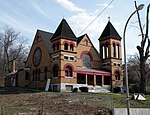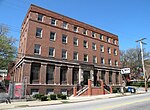Tuberculosis Hospital of Pittsburgh
1912 establishments in PennsylvaniaAllegheny County, Pennsylvania Registered Historic Place stubsBuildings and structures in PittsburghHistoric districts on the National Register of Historic Places in PennsylvaniaHospital buildings completed in 1912 ... and 5 more
Hospital buildings on the National Register of Historic Places in PennsylvaniaNRHP infobox with nocatNational Register of Historic Places in PittsburghPittsburgh building and structure stubsTuberculosis sanatoria in the United States

The Tuberculosis Hospital of Pittsburgh in the Hill District neighborhood of Pittsburgh, Pennsylvania, is a complex of eight buildings, with the first building completed in 1912. It was listed on the National Register of Historic Places in 1993.
Excerpt from the Wikipedia article Tuberculosis Hospital of Pittsburgh (License: CC BY-SA 3.0, Authors, Images).Tuberculosis Hospital of Pittsburgh
White Street, Pittsburgh
Geographical coordinates (GPS) Address Nearby Places Show on map
Geographical coordinates (GPS)
| Latitude | Longitude |
|---|---|
| N 40.453333333333 ° | E -79.968888888889 ° |
Address
White Street 1
15219 Pittsburgh
Pennsylvania, United States
Open on Google Maps







